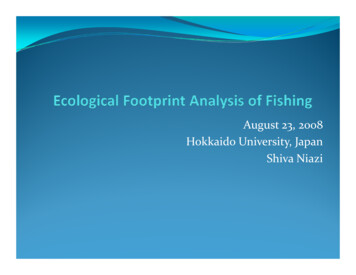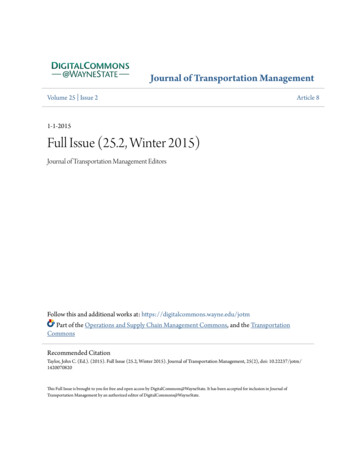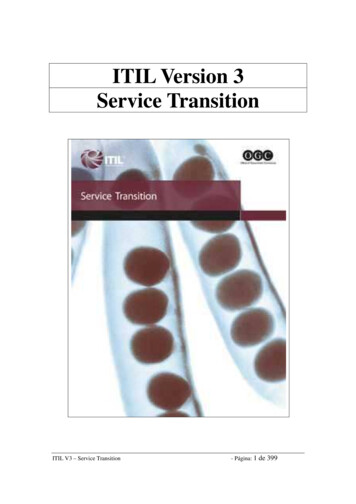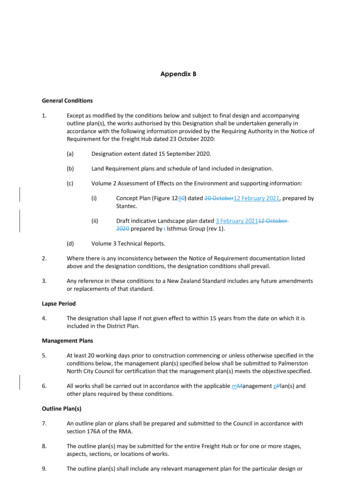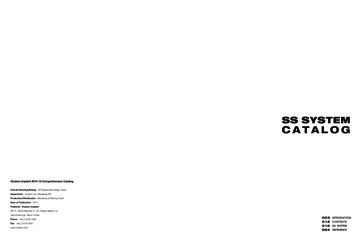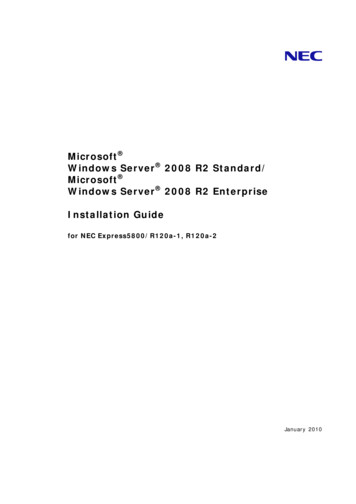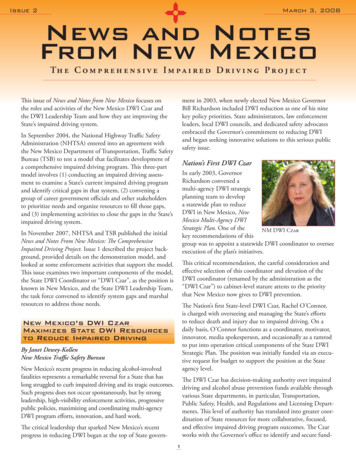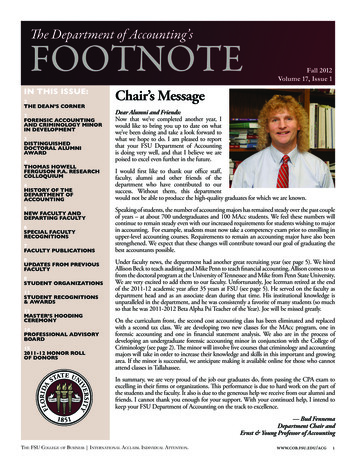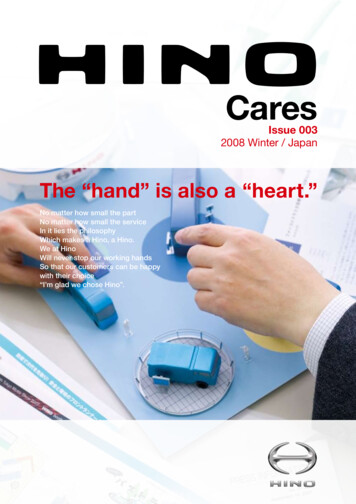
Transcription
CaresIssue 0032008 Winter / JapanThe “hand” is also a “heart.”No matter how small the partNo matter how small the serviceIn it lies the philosophyWhich makes a Hino, a Hino.We at HinoWill never stop our working handsSo that our customers can be happywith their choice“I’m glad we chose Hino”.
HINO Cares HandEstablishing brand confidence in the HINObrand is a task for all of us here at HINO.Shigemi Omori, Deputy General ManagerCorporate Communications Department, Corporate Planning Division“I became more interested in how we coulddesign the event itself to communicate whatHINO was all about in the best way possible. ”It is common knowledge that a “brand” is built on what happens atevery point of contact with our customers. The HINO brand is noexception. There is no doubt that every single interaction or contactthat we have with our customers, from the products themselves –the trucks and buses that our customers use – to the ads that werun to market these products, as well as our sales offices anddealerships, the after-sales services we offer at these sales offices,how we interact with our customers, and how we handle incomingcalls are all important opportunities for us to establish confidence inthe “HINO brand.” This applies to special events as well.This November, the 40th annual Tokyo Motor Show was held atMakuhari Messe. The Tokyo Motor Show, which attracts a greatdeal of international attention, is the largest event of its kind in Japanwhere manufacturers in the automobile industry can showcasetheir products and brand power. Shigemi Omori, Deputy GeneralManager of Corporate Communications Department, CorporatePlanning Division at HINO was the executive producer for the HINObooth at this major event, and he is featured on the cover of thisissue of “HINO CARES” holding a miniature model of the HINO booth.“In contrast to passenger cars, which people choose based onpersonal taste, commercial vehicles are tools that our customersuse in their business operations. So our challenge over the yearshas been to make the best possible use of this Motor Show,which is primarily geared for the mass media, to communicatethe meaning of HINO’s existence in the best way possible” saysOmori, a designer who, before he was transferred to CorporateCommunications Department about 10 years ago, worked in thearea of product and interior color design for 20 years. “Way backthen, I used to come to the Motor Show in my capacity as adesigner. But at one point, I became more interested in how wecould design the event itself to communicate what HINO was allabout in the best way possible.” It wouldn’t be an overstatement tosay that this idea, which was one of the catalysts for Omori to beginworking at PR, had a major impact on the way HINO approachedthe Motor Show. “In the past, HINO just left the Motor Show upto a small contingent of its staff. So I suggested at a corporatemanagement meeting that the entire company should get behindthis opportunity so that we can more thoroughly communicatethe essence of the HINO brand.” Ever since, the Motor Show hasbecome a major communication tool for the HINO brand, whereevent productions are planned on two-year time spans and amanaging organization has been established. In other words,we have built a system where the entire company is now able tocontribute to this event.The responsibilities of Corporate Communications Departmentare focused on media and investor relations, as well as on externalaffairs. But HINO’s PR operations go a step further. An importantaspect of their work is establishing confidence in the HINO brandfrom the perspective of PR in all situations including events such asthe Motor Show. “As we expand our perspectives to a global level,we notice that we can’t communicate what the HINO brand is allabout simply by focusing on HINO’s innovative aspects. Differentcountries and cultures look at different things. To ensure that peoplehave a correct understanding of HINO, it is important to fulfill theneeds of each market and the companies who operate in thesemarkets. Therefore, I believe it is crucial that we are flexible enoughto meet those different needs.” Omori says that, to this end, we mustestablish a corporate attitude where we can put our minds togetheras a company as a whole in response to widely different situations,as opposed to giving the world a pat answer to what HINO is allabout. This former designer is convinced that the atmosphere andnature of his company itself is also subject to design. This attitudereminds us that PR is not only about communicating outside thecompany, but also about internal communication as well.Hino is made by people.
HINO’s ServiceOur customers are also an invaluablepart of our HINO family.Masaru Kuwabara, General Manager, Overseas Parts and Service DivisionMamoru Katano, Manager, Planning and Administration GroupStrategy and Planning Department, Overseas Parts and Service DivisionTadashi Yoshida, Manager, Training GroupStrategy and Planning Department, Overseas Parts and Service Division“We would like to convey a sense ofreassurance to our customers and let themknow that we are always at their side.”From our customers’ perspective, HINO’s products, which arecommercial vehicles, are profit-generating assets. If they stopworking because of breakdowns or other problems, they becomeuseless for generating profit. Commercial vehicles are expectedto operate in rough conditions. Even HINO trucks, with theirexcellent reputation for durability, can encounter problems. So themost important theme for HINO’s after-sales service program is tokeep our customers’ HINO trucks working for as long as possiblewith as little down time as possible. If we were to draw an analogywith a medical organization, the service department, which isresponsible for maintenance, would be the “doctor” and the partsdepartment would be the “pharmacy.” And we have a specialsection in Japan – HINO’s Overseas Parts and Services – whoseprimary task is to train as many “good doctors” as possible anddevelop a system where “medication” is always available anddelivered immediately. We interviewed three of the department’sstaff members who are passionate about establishing a wellorganized, worldwide after-sales service system.Katano: “HINO currently exports its products to about 60 countries.Our products have been received very well at all of the marketsthat we export to, and we believe our unit sales numbers, as wellas the number of new agents, and export markets will continueto grow. This is why one of our major challenges is to reinforceour service programs so that we are able to fully respond to thegrowing number of HINO trucks and models in service. HINO hasparts centers in Ome, Japan, and in Belgium, and these twocenters are responsible for supplying parts to about 60 differentcountries. We are also constantly working to improve our supplysystem to shorten our lead times and improve our servicing rates.”Yoshida: “Another important task of our department is to trainhighly competent individuals who are able to provide excellentservices. We conduct agent trainer training in Japan and incountries such as Panama, Dubai, for their neighboring countries.For example, we invite 100-120 people from 3-40 countries everyyear to Japan, and conduct training sessions for small groupsof 7 people. The trainers who learn new skills in these sessionsthen return to their respective countries and train their mechanics.This year, we launched a learning system dubbed “modulartraining” in some regions. This is a series of software on CD thataddresses 84 areas of HINO maintenance know-how. This allowsmechanics at dealerships, who may not be able to take part intraining, to study on their own. The CD also allows the learners totest themselves so that they are able to see how much progressthey have made. Once the mechanics pass tests in all 84 of theseareas, they are generally ready to tackle all mechanical situationsthat they might encounter with HINO trucks.”Kuwabara: “True to our slogan: ‘HINO, The Brand For GlobalCustomers!’, HINO’s pillar must be a spirit that aspires to become‘Customer Satisfaction No. 1’ regardless of the country. Our workin the area of after-sales service is crucial for our customers’satisfaction and also for having them come back to HINO upon theirnext purchase. The area of after-sales services is wide and deep,ranging from the smooth supply of parts and improved serviceskills – which are a given – to better preventive maintenance,verification of parts prices, the organizing of safety seminars anddriving seminars, and training that helps agents adopt the HINOmindset. Our aim is to improve our quality levels and reassure ourcustomers that we are always at their side. In addition to HINOagents and dealerships, our customers are also part of the HINOfamily. I think it would be safe to say that our goal at the aftersales department is to create a win-win relationship between allfamily members.”Hino, where services also continue to evolve.
HINO Owner’s VoiceWe have taken delivery of over 40,000HINO trucks in total. But it is not just thislarge number that reflects our relationshipwith HINO.Masataka Satake, Deputy General Manager, Seino Transportation Co., Ltd.Shigeru Yano, Operations Section, Operations“ one of the most important reassuringfactors is that they have a 24-hourmaintenance program.”It was a sight to behold – tens of HINO trucks painted in Seino’stwo-tone brand color lined up at the company’s massivedistribution center. Trucks were loaded with their cargo anddrove off one by one to their destinations late in the afternoon.Seino Transportation, known for its Kangaroo delivery services,was founded in Mashita County, Gifu, in 1930. We had a chanceto visit their distribution center in Gifu City for this HINO OwnersVoice interview. This is one of Seino’s primary distributioncenters in the central Japan region. During our stay, driversand other members of the company welcomed our interviewteam with courtesy and open arms. The sense of sincerity andcourtesy that we felt in the behavior of those people appearedto be a product of the company’s culture, and was probably oneof the factors that helped Seino Transportation grow into one ofJapan’s major transport companies.“We currently operate about 11,000 trucks at Seino, of whichabout 8,000 are HINO trucks” explains Mr. Satake, Deputy Chiefof Operations at Seino Transportation. Seino’s relationship withHINO goes back to 1948. For over half a century since HINOsold its first truck to Seino, HINO has delivered a total of over40,000 trucks to the entire Seino Group (as of 2006). We askedMr. Satake the reason that Seino has been using so manyHINO trucks over the years. “They have large loading capacity,and deliver good fuel economy. We’re also impressed by theirpioneering engineering. Another point is that they are less likelyto break down. We have been able to reduce our costs forreplacement parts over the last 10 years or so.” What aboutafter-sales service? “Seino employs about 200 in-house servicepersonnel nationwide, and several tens of these service staffmembers take HINO mechanic seminars each year. Memberswho complete the seminars and have acquired new skills go onto train other mechanics in various parts of the country.”We were also able to listen to some of the stories that reflectedthe trust-based relationship between our two companies, whichhas continued for over half a century. “We often purchase thelatest HINO product, all the same model, in large numbers, assoon as they are launched. So, from a monitoring standpoint,we are able to constantly provide feedback to HINO so thatcomments from our drivers and mechanics, which end up beinga large amount of data, can be incorporated into their futureproducts.” Indeed, many suggestions from Seino have beenincorporated into new HINO trucks. Take, for example, our heavyduty trucks with short cabins (Japan model). These models weredeveloped based on a request from Seino to remove the bedand expand the loading area, in response to eased regulationsthat no longer required two drivers on long-distance runs. At thetime when cabins with a bed were a norm for heavy-duty trucks,HINO became the first in Japan to develop short cabin modelsby removing the bed for heavy-duty trucks. Another feature thatwould not have been realized without Seino’s input is the fronttwo-axle mechanism that is unique to heavy-duty trucks in Japan.In closing, we asked them, “Let’s say you were a HINO sales rep.What would you communicate to your clients?” To this, Mr. Yanoof the Operations Section, Operations, replied, “I used to drivetrucks myself and I know from experience that HINO trucks arevery reassuring to drive. There are many reasons for that – theyare easy to drive, as well as offering good levels of performanceand safety – but one of the most important reassuring factors isthat they have a 24-hour maintenance program.”Hino, because there are reasons to be selected.
HINO TechnologyDesigning HINO from the perspective of the“people” who use HINO. The best solutionwill always continue to evolve.Air InstallationWarm AirCold AirVentilationInterior Intake“The comfortable ride that this systemdelivers was born from the ‘sense ofbalance’ to which HINO is committed.”While the demands on commercial vehicles are diverse,ranging from economy to driving performance, durability,and environmental-friendliness, we must never compromisethe comfort of those who drive and use these vehicles infulfilling these demands. We recognize that “comfort” is alsoan important aspect of commercial vehicles. This is because,we understand that lessening the fatigue and the comfort ofcommercial vehicle drivers, who often drive for many hours aday, will contribute to safe operation. Therefore, HINO makesits vehicles with great attention to detail so that drivers candrive comfortably. “Comfort” is a catch-all term that involvesa broad range of elements includ
HINO has parts centers in Ome, Japan, and in Belgium, and these two centers are responsible for supplying parts to about 60 different countries. We are also constantly working to improve our supply system to shorten our lead times and improve our servicing rates.” Yoshida: “Another important task of our department is to train highly competent individuals who are able to provide excellent .
